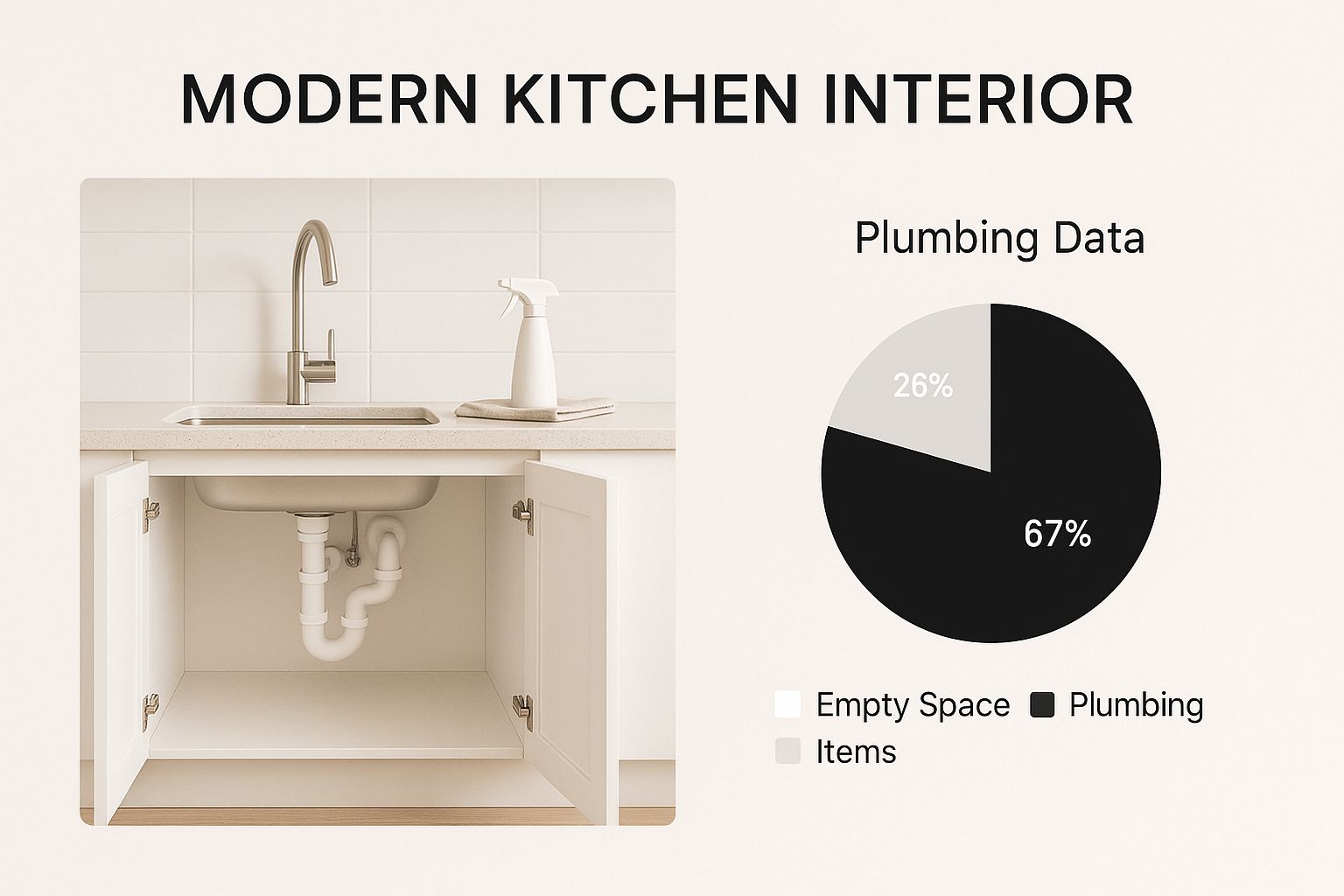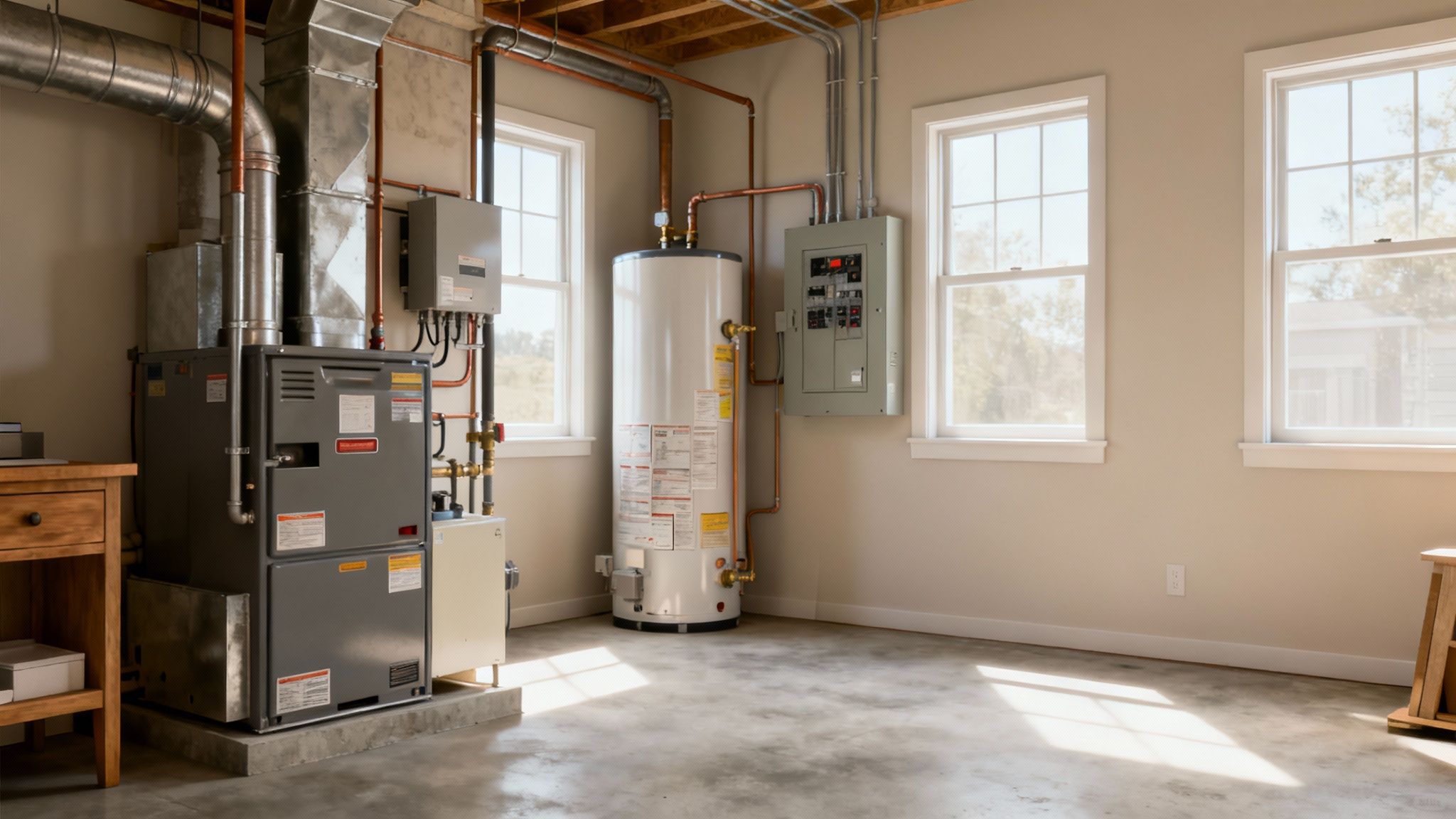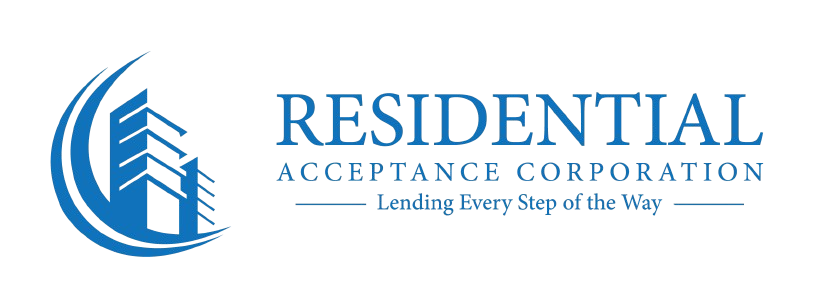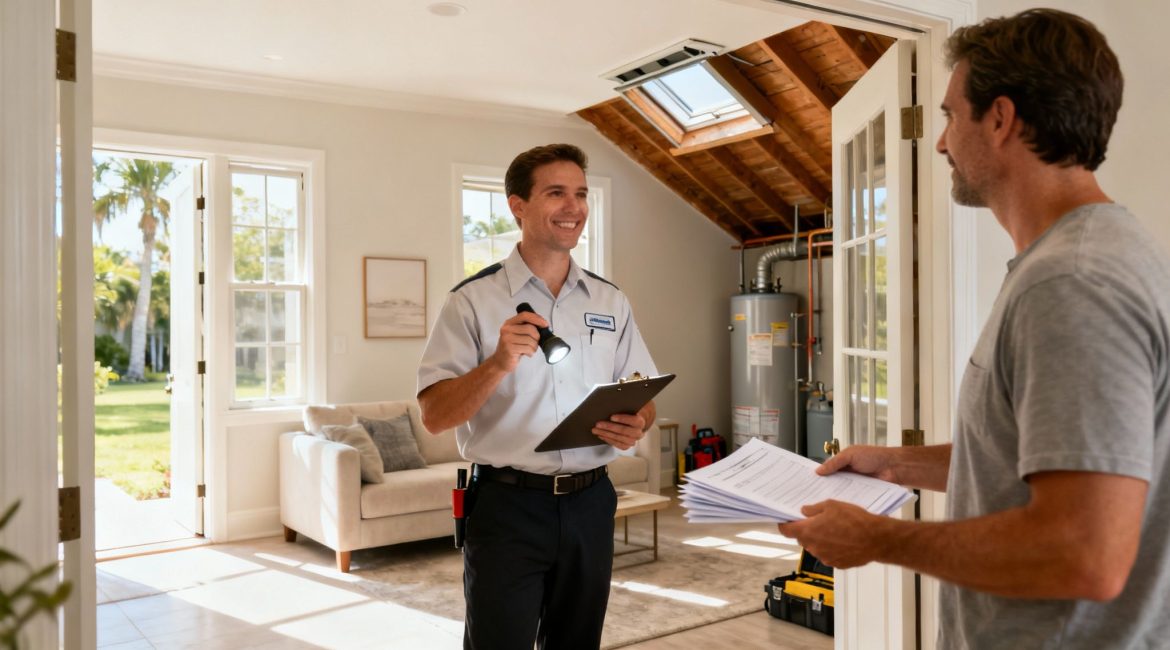Getting ready for a home inspection is part common sense, part strategy. It’s a combination of deep cleaning, knocking out those minor repairs you’ve been putting off, and making sure the inspector can get to all the important spots. Your real goal here is to show off a home that's been cared for, which builds confidence in your buyer and helps you avoid those stressful, last-minute negotiations over small stuff. Honestly, how well this goes can directly affect your final sale price and how quickly you get to the closing table.
Why a Smooth Home Inspection Is Critical in Tampa
In a market as active as Tampa's, the home inspection isn't just another box to check. It's a make-or-break moment. A clean report validates the buyer's choice and keeps you in a strong negotiating position. On the flip side, a report full of surprises can open the door to a flood of repair requests or, in a worst-case scenario, kill the deal entirely.
Think of it as the final exam for your house. Acing it proves your property is a solid investment, justifies the price you're asking, and sets the stage for a much faster and less complicated closing.
Building Buyer Confidence and Trust
When a buyer sees a home that's clearly been looked after, it sends a powerful message. It tells them you've been a responsible owner. If an inspector can move around freely, access all the key systems, and finds everything clean and functioning, it creates an incredible amount of trust. And that trust is everything when someone is about to make one of the biggest purchases of their life.
Taking the time to prepare shows you're transparent and you care. That simple effort often leads to:
- Fewer squabbles over minor, nit-picky issues.
- A much higher chance the buyer will proceed without making big demands.
- An overall more positive and collaborative feel for the rest of the sale.
The Financial Stakes of the Inspection
At the end of the day, the inspection report has a direct impact on your wallet. An unexpected discovery—say, an aging water heater or some questionable wiring—instantly becomes leverage for the buyer. These are the kinds of findings that almost always lead to requests for repair credits or a drop in the sale price.
A clean inspection report is one of your best tools for protecting your home’s value during negotiations. It takes away the buyer's leverage and keeps you in the driver’s seat.
It's also smart to understand how the inspection can influence the mortgage process. While not always a strict requirement, a report with significant problems can sometimes throw a wrench in the buyer's financing. For more detail on this, take a look at our guide that asks is a home inspection required for a mortgage?
This is where working with a local Tampa expert like Residential Acceptance Corporation (RAC Mortgage) really pays off. They know the Tampa market inside and out and can help you and your buyer navigate any financial hiccups that come up after the inspection, making sure your sale stays on course.
The Essential Deep Clean and Declutter Checklist
First impressions count, and that’s especially true with a home inspector. When they walk into a cluttered, messy house, it can subtly suggest a lack of regular upkeep. This isn't about staging your home for a magazine cover; it's about making it inspectable. The real goal is to provide a clean, safe, and open environment so they can do their job efficiently and thoroughly.
This goes way beyond your typical Saturday morning tidy-up. You can't just shove everything into a closet and call it a day. Think from the inspector’s perspective: they need to get under every sink to look for leaks, so all those half-empty cleaning bottles and old sponges have to go. An overstuffed closet could easily be hiding water spots or cracks in the wall behind it.
The infographic below really drives home the point about making key areas, like the plumbing under a sink, completely visible and accessible.

This image is a perfect example of what an inspector wants to see. A clear space under the sink means they can quickly check the pipes for drips and proper function without having to move a mountain of stuff first.
A Tampa Homeowner’s Checklist
If you're a Tampa homeowner prepping for the big day, think "clear pathways." Inspectors absolutely need to get into attics, crawl spaces, and utility closets without having to perform an obstacle course.
Here’s a practical checklist to get your home ready:
- Kitchen and Bathrooms: Completely empty the cabinets under every sink. This gives a crystal-clear view of the plumbing. While you're at it, wipe down the surfaces and fix that nagging little faucet drip.
- Closets and Storage Areas: These aren't just hiding spots for your clutter. Organize them so the inspector can see the back walls. Remember, an attic hatch or electrical panel is often tucked away inside a closet.
- Living Spaces: Pull furniture a few inches away from the walls to expose outlets and vents. It’s also a good time to dust, clean the windows, and replace any burnt-out lightbulbs. A dead bulb can easily be mistaken for a bigger electrical problem.
- Garage and Utility Rooms: Create a wide, clear path to your electrical panel, water heater, and HVAC unit. Sweep the floor and get rid of any potential trip hazards like stray tools or boxes.
Remember, the point of decluttering for an inspection isn't about making it pretty. It's about providing unobstructed access and showing pride of ownership.
When you tackle these items one by one, you’re doing more than just cleaning—you’re taking control of the inspection process. This kind of preparation shows the inspector you’re serious and helps build the buyer’s confidence. That confidence is vital, especially as they move toward finalizing their mortgage with a lender like Residential Acceptance Corporation (RAC Mortgage).
Catching Common Problems Before the Inspector Does
Alright, now that the house is looking its best, it's time to shift gears from general tidiness to the real nuts and bolts. An inspector’s entire job is to find potential problems, so getting ahead of the most common issues is one of the smartest things you can do. This isn't about hiding anything; it's about showing you’ve been a responsible homeowner and preventing small, fixable things from turning into big headaches during negotiations.
If you think your home is perfect, you might be in for a surprise. Research consistently shows that a massive 86% of home inspections uncover at least one issue that needs attention. The usual suspects? Problems with the roof, quirky electrical systems, and windows that don't cooperate—each of these pops up in nearly 20% of inspections.
Your Pre-Inspection Troubleshooting Guide
Here's where you get to play inspector for a day. Walk through your own home with a critical eye and you’ll be amazed at what you notice. Fixing these little things now can make a world of difference in the final report.
For example, your HVAC system is a major inspection point. Before the inspector shows up, run through an ultimate HVAC preventive maintenance checklist to make sure everything is humming along. A simple tune-up can help you avoid a common red flag, especially here in the Tampa climate where a working AC is non-negotiable.
Remember, nobody is looking for a "perfect" house—they don't exist. The goal is to present a well-maintained home that gives a buyer confidence they're making a solid investment.
To help you focus your efforts, here's a breakdown of the most common red flags inspectors find and what you can do about them right now. Addressing these shows potential buyers, and their Tampa mortgage lender Residential Acceptance Corporation (RAC Mortgage), that your home has been cared for.
Common Home Inspection Red Flags and How to Address Them
I've put together this table to walk you through the most frequent trouble spots inspectors flag. These are the areas where a little bit of prep work can have the biggest impact on your inspection report.
| Area of Concern | What Inspectors Look For | Easy Fixes for Homeowners |
|---|---|---|
| Plumbing & Water Intrusion | Active leaks under sinks, slow drains, low water pressure, water stains on ceilings or walls, and signs of moisture in the basement or crawl space. | Check all faucets and toilets for drips. Clear slow drains with a consumer-grade drain cleaner. Look for and address the source of any minor water stains, then prime and paint over them. |
| Electrical System | Non-functional outlets, broken light switches, missing GFCI outlets in kitchens/baths, exposed wiring, and an overloaded or outdated electrical panel. | Replace burnt-out light bulbs (so they don’t get mistaken for a wiring issue). Test every outlet and switch. Ensure all cover plates are intact and not cracked. |
| HVAC System | Dirty filters, poor airflow from vents, thermostat malfunctions, and signs of leaking or rust on the unit itself. | Replace the air filter—this is one of the easiest and most impactful fixes. Clean dust and debris from around the exterior unit to ensure proper airflow. |
| Roof & Gutters | Missing or damaged shingles, clogged gutters filled with leaves, and downspouts that don't direct water away from the foundation. | Visually inspect your roof from the ground for obvious issues like missing shingles. Clean out all gutters and downspouts to ensure proper drainage. |
| Doors & Windows | Windows that don't open or close properly, cracked window panes, broken seals (fogging between panes), and doors that stick or don't latch correctly. | Lubricate window tracks for smooth operation. Fix or replace any cracked panes. Adjust door hinges if they are sticking. |
Taking an hour or two to check these items off your list can save you from a lot of unnecessary stress and back-and-forth later. It’s all about making the process as smooth and predictable as possible.
Granting Full Access to Key Systems and Areas

Here's a simple truth about home inspections: an inspector’s report is only as complete as the access you provide. If they can't get to something, they can't inspect it. This often leads to frustrating delays, follow-up visits, or unnecessary red flags on the final report.
You’ve already put in the work cleaning and handling repairs. The final piece of the puzzle is making sure every important area of your home is wide open for evaluation. Think about the places you don't go every day. Is that heavy bookshelf pushed up against the electrical panel? Is the attic hatch buried under a pile of boxes? An inspector marking an area as "inaccessible" can make buyers nervous, even if you weren't trying to hide anything.
Creating Clear Pathways to Critical Zones
Your goal should be to make the inspector's job as smooth and efficient as possible. Picture them walking through your Tampa home, flashlight in hand. Every minute they have to spend squeezing past your stuff is a minute they aren't spending on the actual inspection.
Make sure you've carved out a clear, unobstructed path to these key systems:
- Electrical Panel: You need to leave at least a three-foot clearance in front of the panel. Inspectors absolutely have to open it up to check the breakers and wiring.
- HVAC System: Both the indoor furnace or air handler and the outdoor condenser unit must be easy to get to. Don't forget to trim back any bushes or plants that are crowding the outdoor unit.
- Water Heater: Clear out any clutter or storage items packed around the water heater. They need to get a good look at it to check for leaks, corrosion, and proper ventilation.
- Pool Equipment: For a lot of Tampa homes, this is a big one. The pool pump, filter, and heater are major inspection points, so ensure the area is tidy and they can walk around it freely.
An inspector marking an area as "uninspectable" due to lack of access creates uncertainty for the buyer. This simple-to-fix issue can introduce doubt and complicate negotiations.
Unlocking and Organizing for Transparency
Beyond just clearing a path, you need to think about locks. Go through the property and make a list of every locked door, gate, or panel. From sheds and utility closets to crawl space hatches, make sure you leave the keys in a visible, clearly labeled spot.
Here’s another pro tip: gather up any important paperwork you have for your home’s major systems. This isn’t required, but it shows you've been a proactive homeowner and gives the inspector valuable context.
Try to pull together a folder with things like:
- Recent HVAC service records
- Receipts for any big-ticket repairs (like a new roof or water heater)
- Warranties for appliances staying with the home
This kind of preparation goes a long way in building trust. It helps the buyer, and their lender Residential Acceptance Corporation (RAC Mortgage), feel much more confident that they're making a smart investment in a well-cared-for property.
Your Game Plan for Inspection Day
Alright, inspection day is on the calendar. A little bit of smart prep now can save you a world of headaches later. What we're aiming for here isn't perfection—it's about making sure the inspector can do their job efficiently and get a clear picture of the home. Think of it as setting the stage for a smooth final act.
First thing’s first: make sure all the utilities are on. I’m talking water, gas, and electricity. This is a classic, easy-to-miss detail, especially if the house is vacant. If the power's off, the inspector can't test the HVAC, check the hot water, or run the appliances. That means an incomplete report and the hassle of scheduling (and paying for) a re-inspection.
Setting the Stage for Success
With the essentials handled, let's focus on the little things that make a big difference. Before you head out, turn on every single light in the house and open up all the blinds and curtains. It instantly makes the home feel more welcoming and, just as importantly, saves the inspector from hunting for light switches in rooms they've never been in.
Next up, your furry family members. It's best to have pets out of the house for the inspection, which usually takes about two to four hours. Even the most well-behaved dog can be a distraction or a potential trip hazard when the inspector is navigating tight spots like a crawl space.
Your goal isn't to get a "perfect score" on the report—because no home is perfect. The real objective is to help the inspector conduct an accurate, thorough assessment of your property's condition.
While it's a good idea to keep your phone on you, plan to be away from the property during the inspection itself. This gives the inspector and the buyer the space they need to look things over and discuss findings openly without anyone feeling awkward or pressured. It’s a professional courtesy that really helps build trust. A smooth inspection process also gives lenders like Residential Acceptance Corporation (RAC Mortgage) confidence that the deal is on solid footing, which helps keep everything moving toward closing day.
The world of home inspections is always changing, and good inspectors are constantly learning to keep up. They're not just looking at the foundation anymore; they're assessing everything, including newer eco-friendly features. If you're curious about what goes into their training, you can learn more about how inspectors prepare for the future on ahit.com.
Understanding Your Report and Finalizing the Sale
The inspector has packed up and left. Now what? Soon, you'll receive the full inspection report, and this document is your guide for the final stretch of the sale. It’s easy to feel a little anxious, but remember, this isn't a simple pass-or-fail exam.
Think of the report as a professional health check-up for your house. It's designed to separate the serious, structural problems from the minor, everyday fixes.
Navigating Negotiations and Closing
When you get the report, take a deep breath and review it with a level head. Your focus should be on anything flagged as a safety hazard or a major system defect—things like the roof, HVAC, plumbing, or electrical systems. These are the items the buyer will care about most.
In a place like Tampa, for example, it’s not uncommon to see notes about humidity or an older A/C unit that’s still kicking but might not have many years left. Understanding what's typical for the area helps you keep things in perspective.
With the report in hand, you'll likely enter a new round of negotiations. The buyer might ask you to make specific repairs, lower the price, or offer a credit at closing to cover the cost of the work. Your job is to figure out what's a reasonable request versus what's just a cosmetic preference. A faulty electrical panel is one thing; a request to repaint a room is another.
This is where having a local expert like Residential Acceptance Corporation (RAC Mortgage) in your corner makes a huge difference. They know the common inspection findings in the Tampa market and can help both you and the buyer work through any financing tweaks needed to get the deal done.
The inspection report isn't a list of demands; it's a roadmap to the closing table. The goal is to tackle the big issues together and not get bogged down by the small stuff.
Their experience turns potential deal-breakers into manageable solutions. By helping everyone understand the financial side of the report, RAC Mortgage acts as a steady guide to see your sale through to the end.
If you're curious about what comes next in the property valuation process, our article on how to choose an appraisal management company for your needs is a great resource.
Answering Your Lingering Home Inspection Questions
Even after you've checked every box on your prep list, it’s completely normal to have some last-minute questions as inspection day gets closer. I see it all the time with Tampa homeowners—a bit of anxiety creeps in. What if the inspector finds something I missed? How big of a deal is this crack or that leak?
Let's clear the air on a few of the most common questions I hear. Getting these answers straight will help you walk into the inspection with confidence.
"Do I Really Have to Fix Everything on the Report?"
This is, without a doubt, the number one question sellers ask. The simple answer is no. You are not legally obligated to fix every single item flagged on an inspection report.
Think of the report less as a to-do list and more as a starting point for negotiation. The real focus should always be on significant issues—things that affect health, safety, or the core function of the home. Minor cosmetic flaws are just that: minor.
Separating the Big Deals from the Small Stuff
Knowing how to tell a major red flag from a minor handyman fix is crucial. It’s the difference between a deal-breaker and a simple negotiation point.
- Major Issues: These are the heavy hitters. Think of a leaky roof, a failing HVAC system, evidence of termites, or an outdated electrical panel. These often require professional repair and are legitimate points of concern for a buyer.
- Minor Issues: This category includes things like a dripping faucet, a cracked outlet cover, a sticky window, or a loose handrail. Most buyers will see these as routine maintenance items they'll handle after moving in.
Here’s a piece of advice I always give sellers: Don’t get defensive if the report isn't perfect. No house is. The goal is to show you're reasonable by addressing the buyer's legitimate concerns about safety and major systems. That’s what keeps the deal on track.
"Should the Buyer Come to the Inspection?"
Another frequent concern is about the buyer's presence. My take? Yes, they absolutely should be there, and it's actually a good thing for you.
When buyers attend, they get to see the home's condition with their own eyes and hear the inspector's feedback directly. This often provides context that a written report can't. Your job is simple: provide full access to the property and then give them space. Let the inspector and the buyer have their conversation—transparency here builds trust.
Remember, the inspection is just one piece of the puzzle. Getting your financial paperwork lined up is just as critical for a seamless closing. If you need a quick refresher, our guide on what documents are needed for a mortgage is a great resource to make sure you have everything in order.
Navigating the final hurdles of selling your home is always easier when you have a trusted partner in your corner. Here at Residential Acceptance Corporation, we’ve helped countless members of the Tampa community by providing clear guidance and dependable mortgage solutions. We're here to make sure your journey from inspection day to the closing table is as smooth as it can be. Visit us at https://racmortgage.com to get started.

